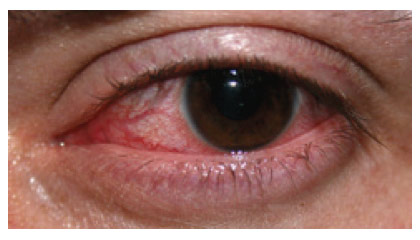By Linda Conlin, ABOC, NCLEC Dry eye syndrome is the lack of sufficient lubrication and moisture on the surface of the eye because of decreased quality or quantity of tears. As a result, patients suffer constant discomfort from eye irritation and longer healing time if they have had refractive surgery. Symptoms include persistent dryness, scratchiness, burning, foreign body sensation and blurred vision, light sensitivity and surprisingly, tear overproduction (Fig. 1).
Dry eye syndrome is the lack of sufficient lubrication and moisture on the surface of the eye because of decreased quality or quantity of tears. As a result, patients suffer constant discomfort from eye irritation and longer healing time if they have had refractive surgery. Symptoms include persistent dryness, scratchiness, burning, foreign body sensation and blurred vision, light sensitivity and surprisingly, tear overproduction (Fig. 1).
Fifty percent of contact lens dropouts are associated with discomfort from dry eye. The syndrome is more common in smokers and women, especially following blepharoplasty that resulted in incomplete lid closure. Dry eye affects an estimated 10 to 30 percent of the population, although the actual percentage may be much higher because not everyone who may have the syndrome seeks professional attention. What’s more, the incidence of dry eye is increasing due to an aging population as well as increased computer use. When using computers, people blink at a rate that is about one-third the normal blink rate, decreasing lubrication of the eye.
While no cure for dry eye syndrome presently exists, ECPs can help patients manage the symptoms. Do not forget that patients can alleviate dry eye symptoms using wraparound sunglasses with side shields, indoor air filters and humidifiers, checking with their doctors to change medications that have dry eye as a side effect and resting their eyes during visually demanding tasks. See this CE course for the complete discussion.
August 2017
Eyes/Optics













